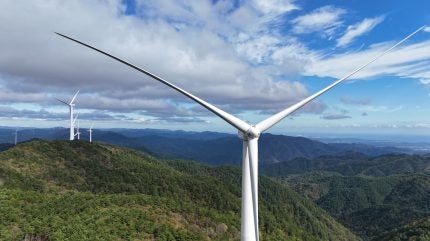
Fukushima Fukko Furyoku (FFF) has begun commercial operations at its 147MW Abukuma wind power project in Japan.
FFF is a joint venture between nine companies: Fukushima Electric Power, Fukushima Mirai Kenkyukai, Japan Wind Engineering, JR East Energy Development, Obyashi Clean Energy, Renova, the Shimizu Corporation, Shinobuyama Fukushima Power and the Sumitomo Corporation.
The Abukuma wind project is located in Fukushima prefecture, spanning the municipalities of Tamura, Okuma, Namie and Katsurao. It is Japan’s largest onshore wind farm, comprising four power plants and 46 GE Vernova 3.2 MW–103m wind turbines, each with a capacity of 3.2MW.
The project generates 360 million kilowatt hours (kWh) per year, sufficient to power 120,000 households, and will operate until March 2045.
GE Vernova wind segment chief commercial officer David Hardy stated: “We are pleased to announce the start of operation of this critically important wind farm for Japan, along with our consortium members.
“The Abukuma wind farm is powered by technology that is developed to minimise environmental impact and cope with extreme weather conditions in Japan, re-inforcing our commitment to supporting our customers in meeting Japan’s ambitious renewable energy and wind power goals.”

US Tariffs are shifting - will you react or anticipate?
Don’t let policy changes catch you off guard. Stay proactive with real-time data and expert analysis.
By GlobalDataInitially set to operate under Japan’s feed-in tariff (FIT) system, the wind farm transitioned to the feed-in premium (FIP) system upon launch.
This shift allows for direct transactions with power consumers through corporate power purchase agreements (PPAs).
Sumitomo will purchase all renewable energy and environmental credits generated by the farm, acting as an aggregator and entering into PPAs with various businesses.
The wind project is part of the Fukushima prefecture’s initiative to produce more than 100% of its energy requirements from renewable sources by 2040.
Fukushima Fukko Furyoku representative Hirano Takayuki stated: “We are proud to have accomplished this meaningful project together with GE Vernova in Fukushima. We believe this wind farm will contribute to the region’s economic development for years to come, generating local employment opportunities and other positive impacts.
“From a decarbonisation perspective, we also see this project as helping Fukushima prefecture become a leading region in the adoption of renewable energy on the global stage.”
A portion of the revenue from the wind farm’s energy sales will fund reconstruction projects in local municipalities through the Fukushima Prefecture Renewable Energy Reconstruction Promotion Council.
The project’s financial support includes subsidies from Fukushima prefecture, aligning with the Fukushima Renewable Energy Promotion Vision and the Fukushima New Energy Society Concept.
Kamome Mirai Fisheries, Okuma Town Hall, SUMCO and other undisclosed domestic companies are among the project’s power consumers.
In February 2025, Japan’s government approved new climate, energy and industrial policies to cut greenhouse gas emissions by 2040.



